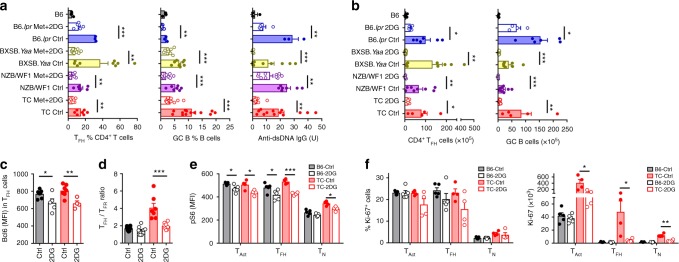Fig. 2.
Autoreactive TFH cells are sensitive to glycolysis inhibition. Frequency (a) and cell number (b) of TFH cells (left, CD4+CXCXR5+PD1+Bcl6+Foxp3−) in CD4+ T cells and GC B cells (middle, B220+GL7+FAS+) in B cells, as well as serum anti-dsDNA IgG (right) in four strains of lupus-prone mice treated with 2DG for 8 weeks starting at 5–6 months of age, as compared to untreated age-matched controls. Contemporaneous untreated B6 mice are shown as reference. Mean + s.e.m. of N = 3–28 mice per group. c–f 3–4-month-old B6 and TC mice were treated 2DG or not for 1 month. MFI of Bcl6 in TFH cells (c) and the ratio of TFH (CD4+CXCXR5+PD1+Bcl6+Foxp3−) to TFR (CD4+CXCXR5+PD1+Bcl6+Foxp3+) cells (d). Phospho-S6 (e) as well as frequency and number of Ki-67+ (f) cells in TN cells (CD4+ CD44−), TAct cells (CD4+CD44+), and TFH cells (CD4+CD44+PD-1hiPSGL-1lo). Mean + s.e.m. of N = 4–9 spleens per group compared with t tests. *P < 0.05, **P < 0.01, and ***P < 0.001

